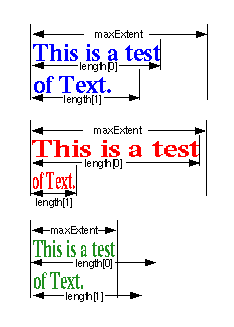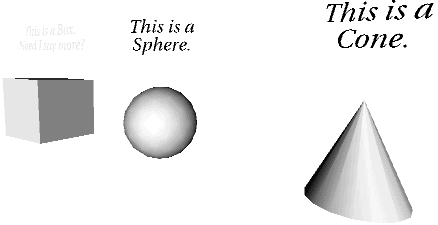Text {
exposedField MFString string []
exposedField SFNode fontStyle NULL
exposedField MFFloat length [] # [0, )
exposedField SFFloat maxExtent 0.0 # [0,
)
exposedField SFFloat maxExtent 0.0 # [0, )
}
)
}
3.47.1 Introduction
The Text node specifies a two-sided, flat text string object positioned
in the Z=0 plane of the local coordinate system based on values defined
in the fontStyle field (see FontStyle node).
Text nodes may contain multiple text strings specified using the UTF-8
encoding as specified by ISO 10646-1:1993 (see [UTF8]). The text strings are stored in the
order in which the text mode characters are to be produced as defined
by the parameters in the FontStyle node.
The text strings are contained in the string field. The fontStyle
field contains one FontStyle node that
specifies the font size, font family and style, direction of the text
strings, and any specific language rendering techniques that must be
used for the text.
The maxExtent field limits and compresses all of the text
strings if the length of the maximum string is longer than the maximum
extent, as measured in the local coordinate system. If the text string
with the maximum length is shorter than the maxExtent, then
there is no compressing. The maximum extent is measured horizontally
for horizontal text (FontStyle node: horizontal=TRUE)
and vertically for vertical text (FontStyle
node: horizontal=FALSE). The maxExtent field shall be
>= 0.0.
The length field contains an MFFloat value that specifies the
length of each text string in the local coordinate system. If the
string is too short, it is stretched (either by scaling the text or by
adding space between the characters). If the string is too long, it is
compressed (either by scaling the text or by subtracting space between
the characters). If a length value is missing (for example, if there
are four strings but only three length values), the missing values are
considered to be 0. The length field shall be >= 0.0.
Specifying a value of 0 for both the maxExtent and length
fields indicates that the string may be any length.

Figure 3-56: Text Node maxExtent and length Fields
3.47.2 ISO 10646-1:1993 Character Encodings
Characters in ISO 10646 are
encoded in multiple octets. Code space is divided into four units, as
follows:
+-------------+-------------+-----------+------------+
| Group-octet | Plane-octet | Row-octet | Cell-octet |
+-------------+-------------+-----------+------------+
ISO 10646-1:1993 allows two basic forms for characters:
-
UCS-2 (Universal Coded Character Set-2). This form is also known as the
Basic Multilingual Plane (BMP). Characters are encoded in the lower two
octets (row and cell).
-
UCS-4 (Universal Coded Character Set-4). Characters are encoded in the
full four octets.
In addition, three transformation formats (UCS Transformation Format or
UTF) are accepted: UTF-7, UTF-8, and UTF-16. Each represents the nature
of the transformation: 7-bit, 8-bit, or 16-bit. UTF-7 and UTF-16 are
referenced in [UTF8].
UTF-8 maintains transparency for all ASCII code values (0...127). It
allows ASCII text (0x0..0x7F) to appear without any changes and encodes
all characters from 0x80.. 0x7FFFFFFF into a series of six or fewer
bytes.
If the most significant bit of the first character is 0, the remaining
seven bits are interpreted as an ASCII character. Otherwise, the number
of leading 1 bits indicates the number of bytes following. There is
always a zero bit between the count bits and any data.
The first byte is one of the following. The X indicates bits available
to encode the character:
0XXXXXXX only one byte 0..0x7F (ASCII)
110XXXXX two bytes Maximum character value is 0x7FF
1110XXXX three bytes Maximum character value is 0xFFFF
11110XXX four bytes Maximum character value is 0x1FFFFF
111110XX five bytes Maximum character value is 0x3FFFFFF
1111110X six bytes Maximum character value is 0x7FFFFFFF
All following bytes have the format 10XXXXXX.
As a two byte example, the symbol for a register trade mark is ®
or 174 in ISO/Latin-1 (8859/1). It is encoded as 0x00AE in UCS-2 of ISO
10646. In UTF-8, it has the following two byte encoding: 0xC2, 0xAE.
design note
Typically, browsers must consider three parameters when choosing which
system font best matches the requested font in the VRML file: the UTF-8
character set contained in Text's string field, and the family
and style fields specified in FontStyle. Browsers shall adhere
to the following order of priority when choosing the font: character
set, then family, then style.
3.47.3 Appearance
Textures are applied to text as follows. The texture origin is at the
origin of the first string, as determined by the justification. The
texture is scaled equally in both S and T dimensions, with the font
height representing 1 unit. S increases to the right, and T increases
up.
"2.14 Lighting model" has details
on VRML lighting equations and how Appearance, Material and textures
interact with lighting.
The Text node does not participate in collision detection.
design note
Significant performance opportunities exist for implementations that
avoid generating polygons when rendering the Text node. One approach is
to generate two-component (luminance plus alpha with a Material node
for color) or four-component (full color plus alpha) texture maps, and
apply the generated texture to a rectangle, instead of rendering the
explicit polygons at each frame.
A second, potentially complementary, approach is to manage the visible
complexity of the text adaptively as a function of distance from the
user. A simple method is to generate multiple levels of detail for the
text automatically, ranging from high to low resolution plus a very low
resolution via "greeking" methods, and lastly to generate an
empty level. An even better optimization might combine the texture map
generation scheme with the adaptive complexity technique.
And finally, implementations will find it necessary to implement a
caching scheme to avoid regenerating the polygons or texture maps at
each frame.
tip
The Text node is the most dangerous performance sink in VRML since it
is easy to create objects that generate large amounts of polygons.
Typically, each character of the Text node generates a set of polygons
that can quickly become the limiting factor in your scene's rendering
time. Use this node sparingly and limit the strings to short, simple
labels.
If you need to present a lot of text to the user, put your VRML world
inside a Web page that also contains HTML, or use ImageTexture nodes to
display the text. As of this writing (early 1997), The World Wide Web
Consortium is in the middle of standardizing the HTML tags used to do
this. See their web site for details--http://www.w3.org;
information on HTML can be found at http://www.w3.org/pub/WWW/MarkUp/Activity.
Even though the VRML standard calls for internationalized text, VRML
browsers will probably not be able to display every possible
international character due to the lack of complete international
fonts.
tip
Use LOD nodes as parents of Text to reduce rendering load when Text is
not important.
tip
Use the emissiveColor field of the Material node to set the Text
color, and set all other material properties to zero. This produces
more readable text (i.e., not subject to lighting effects) and thus
significant performance gains in implementations that recognize the
hint
Shape {
appearance Appearance {
material Material { # Hint to browser to ignore lighting
diffuseColor 0 0 0 # black
specularColor 0 0 0 # black
ambientIntensity 0.0 # black
shininess 0.0 # none
emissiveColor 1 1 1 # white or whatever
}
}
geometry Text { string "testing" }
}
tip
Combine a Text node with a screen-aligned Billboard
node (i.e., axisOfRotation (0, 0, 0)) to
create Text that is readable from any direction. This is especially
effective for labels that follow the user's gaze:
Billboard {
axisOfRotation 0 0 0
children Shape {
geometry Text { string "Smart Label" }
}
}
The following example illustrates three typical cases of the Text node
(see Figure 3-57). The first Text node shows fully lit 3D text
floating over a Box. The text is fixed in space and is readable when
the user navigates to face the text. Notice that this text is
illuminated by the light source and becomes unreadable when the light
shines directly on it (fades into background). The second Text node is
combined with a screen-aligned Billboard to face the user at all times.
The Material node turns off lighting and results in improved text
readability. The third Text node also combines with a Billboard and
turns lighting off, but billboards around the Y-axis to face the user:
#VRML V2.0 utf8
Group { children [
Transform {
translation -5 0 0
children [
Shape {
geometry Box {}
appearance DEF A1 Appearance {
material Material { diffuseColor 1 1 1 }
}
}
Transform {
translation 0 2.5 0
children Shape {
geometry Text {
string [ "This is a Box.", "Need I say more?" ]
fontStyle DEF FS FontStyle {
size 0.5
family "SERIF"
style "ITALIC"
justify "MIDDLE"
}
}
appearance USE A1
}}]}
Billboard {
axisOfRotation 0 0 0 # Screen-aligned
children [
Shape { geometry Sphere {} appearance USE A1 }
Transform {
translation 0 2.5 0
children Shape {
appearance DEF A2 Appearance {
material Material { # Hint to render fast
diffuseColor 0 0 0
ambientIntensity 0
emissiveColor 0 0 0
}
}
geometry Text {
string [ "This is a", "Sphere." ]
fontStyle USE FS
}
}}]}
Transform {
translation 5 0 0
children Billboard {
axisOfRotation 0 1 0 # Billboard around Y-axis
children [
Shape { geometry Cone {} appearance USE A1 }
Transform {
translation 0 2.5 0
children Shape {
appearance USE A2
geometry Text {
string [ "This is a", "Cone." ]
fontStyle USE FS
}
}}}]}
Background { skyColor 1 1 1 }
NavigationInfo { type "EXAMINE" }
]}

Figure 3-57: Text Node Example

